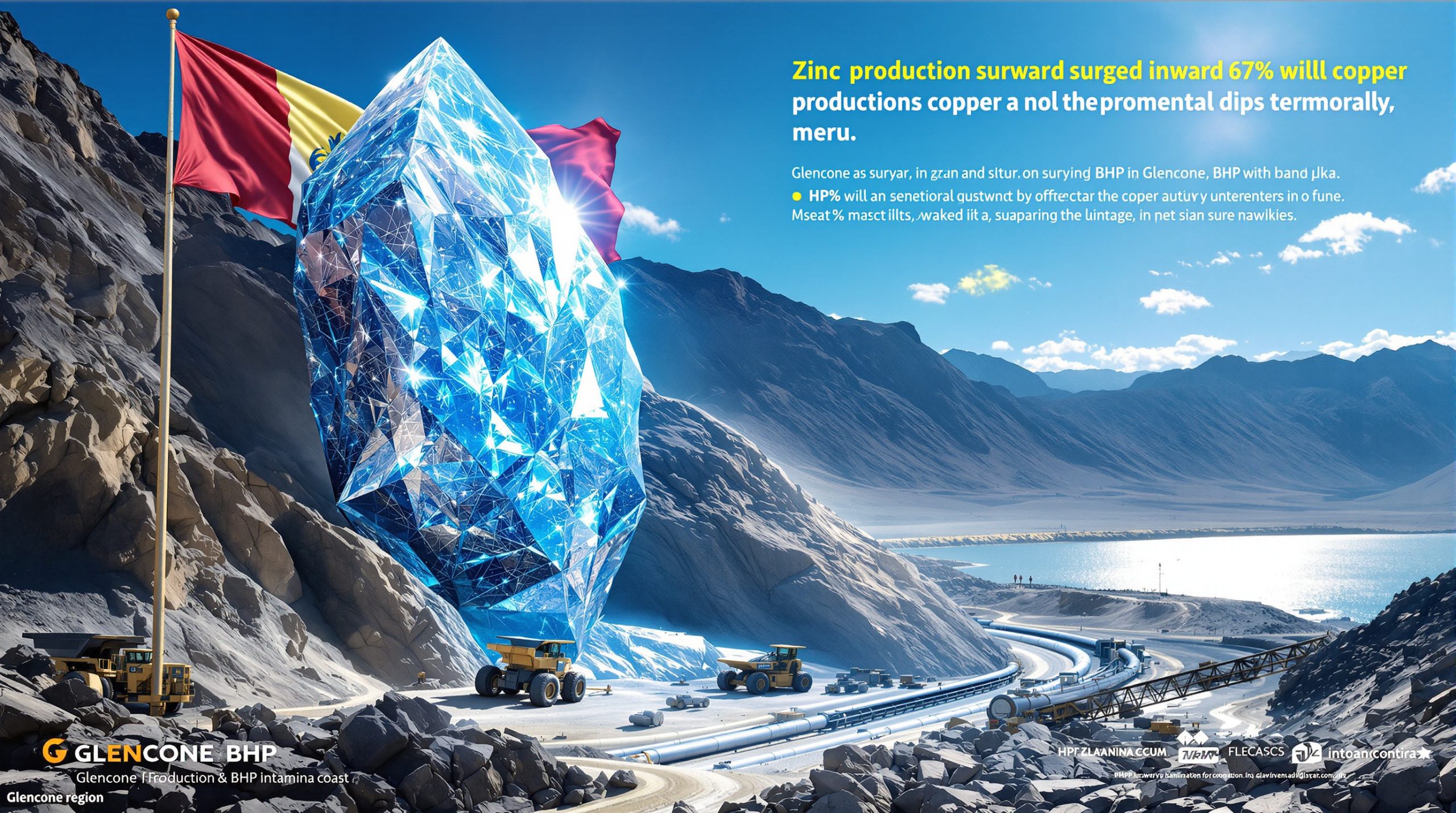What is the Thacker Pass Lithium Project?
Project Overview and Strategic Importance
Located in Nevada's Humboldt County, Thacker Pass represents one of North America's largest undeveloped lithium resources. This strategic asset is structured as a joint venture between Lithium Americas (62% ownership) and automotive giant General Motors (38% ownership), positioning it as a cornerstone of America's domestic battery supply chain ambitions.
The project's scale is impressive, with substantial lithium deposits that could support multiple decades of production. Targeting first production by 2028, Thacker Pass stands to become a critical contributor to reducing America's dependence on foreign lithium sources, particularly as electric vehicle production accelerates across the continent.
Notably, the project has already secured major regulatory approvals following a comprehensive mining permitting process. This marks a significant milestone in the challenging landscape of critical mineral development in the United States, where permitting timelines have often extended for many years.
From a geopolitical perspective, Thacker Pass represents more than just a mining operation – it embodies America's strategic pivot toward securing domestic supplies of materials deemed essential for economic and national security.
Current Development Status
Phase 1 construction activities are progressing at Thacker Pass following the successful navigation of the permitting process. The project has overcome significant regulatory hurdles, though not without controversy from some environmental and indigenous groups who raised concerns about potential impacts.
The development timeline now focuses on building out the integrated processing facilities that will transform raw lithium into battery-grade materials. This vertical integration strategy differentiates Thacker Pass from many other lithium brine insights projects that ship concentrate overseas for processing.
Infrastructure development is being coordinated with local authorities and utility providers, addressing crucial needs including water access, power transmission, and transportation logistics. These elements are particularly challenging in Nevada's remote mining regions but essential for operational viability.
The project's environmental management program includes specific mitigation measures developed through the Environmental Impact Statement process, addressing water usage, wildlife protection, and reclamation planning. These components were critical in securing the necessary federal approvals to advance the project.
Why is the US Government Considering an Equity Stake?
Strategic Mineral Security Policy
Recent reports indicate the US government is in negotiations to acquire what officials describe as a "small stake" in Thacker Pass. This potential investment comes as part of a broader renegotiation of an existing $2.3 billion Department of Energy loan package.
This approach follows established "policy-for-equity" precedents the government has pursued with other critical mineral projects, including rare earth producer MP Materials and semiconductor manufacturers like Intel. These investments represent a tangible manifestation of bipartisan agreement that certain supply chains require direct government support to develop domestically.
The policy direction reflects growing recognition that traditional market forces alone may be insufficient to establish competitive domestic supply chains in sectors where other nations have established dominance. In lithium processing, China currently controls approximately 60% of global capacity, creating vulnerability for Western automotive and technology companies.
By potentially taking an ownership position in Thacker Pass, the US government signals long-term commitment to domestic lithium production regardless of administration changes. This continuity is particularly valuable for projects with development timelines stretching beyond political cycles.
Financial and Market Implications
The market reaction to reports of potential government equity participation was immediate and dramatic. Lithium Americas stock surged nearly 100% in after-hours trading following the news, demonstrating the significant impact government backing can have on investor confidence.
This response highlights how government participation fundamentally changes the risk profile for large-scale projects requiring substantial capital investment. The implied backing reduces concerns about financing availability, political obstacles, and regulatory uncertainty.
For project developers, government equity participation can transform the economics of raising capital. When investors see reduced execution risk and implied policy protection, they typically require lower risk premiums, effectively lowering the overall cost of capital.
This dynamic creates a virtuous cycle where improved financing terms accelerate development timelines, which in turn enhances project economics and attracts additional private capital. The government stake effectively serves as a seal of approval that can influence other stakeholders throughout the supply chain.
How Does Government Participation Benefit Lithium Projects?
Reduced Capital Costs and Improved Financing Terms
Government equity participation fundamentally alters the financing landscape for critical mineral projects. When government entities become shareholders, they bring more than just capital – they bring implicit guarantees that substantially reduce perceived risk.
This risk reduction translates directly into more favorable debt terms from commercial lenders. Banks and financial institutions typically offer lower interest rates, longer repayment periods, and less restrictive covenants when government backing is present. The resulting blended financing packages combine government loans, grants, tax incentives, and private capital at more favorable overall terms.
For lithium developers, this cost advantage can be decisive in making marginal projects economically viable or accelerating the development of established resources. In an industry where capital costs often reach billions of dollars before generating revenue, reducing the weighted average cost of capital by even a few percentage points can transform project economics.
The capital structure advantages extend beyond the initial development phase. Government participation often facilitates access to specialized funding programs for expansion, technology upgrades, or downstream integration that might otherwise be unavailable to purely commercial enterprises.
Accelerated Permitting and Regulatory Processes
One of the most significant practical benefits of government participation comes in navigating complex regulatory landscapes. When government agencies become stakeholders, they gain direct interest in seeing projects advance efficiently through permitting processes.
This alignment creates internal advocates within the government who can help coordinate between various federal agencies including the Bureau of Land Management, Environmental Protection Agency, Department of Energy, and others that influence project timelines. While regulatory standards remain unchanged, the visibility and predictability of permitting pathways often improve substantially.
For critical mineral projects on federal lands, this coordination function is particularly valuable. Instead of facing sequential, sometimes contradictory requirements from different agencies, projects with government participation often benefit from more cohesive, parallel processes that reduce overall timeline uncertainty.
The improved regulatory visibility extends beyond federal agencies to state and local authorities. Government equity participation signals the national importance of projects, often encouraging alignment across all levels of government rather than confrontation between them.
Enhanced Commercial Opportunities
Government backing dramatically strengthens a project's position in negotiations with potential customers and strategic partners. For lithium producers, this translates into more favorable offtake agreements with automotive manufacturers and battery producers.
When government stakeholders demonstrate commitment to a project's success, customers gain confidence in supply reliability and timeline certainty. This confidence often leads to better pricing terms, including minimum price guarantees, inflation adjustments, and other provisions that protect producer economics through market cycles.
The enhanced credibility also increases the likelihood of securing prepayment arrangements, where customers provide upfront capital in exchange for future production. These arrangements represent a powerful financing tool that reduces reliance on traditional debt and equity markets.
Beyond customer relationships, government participation facilitates strategic partnerships across the battery supply chain. These connections often bring additional technical expertise, market access, and operational synergies that further enhance project value and development efficiency.
Which ASX-Listed Companies Could Benefit?
Australian Companies with North American Lithium Projects
Ioneer (ASX: INR) has positioned itself as a leading contender in the US lithium landscape with its Rhyolite Ridge lithium-boron project in Nevada. The project's advanced permitting status and construction-ready timeline make it particularly well-aligned with US policy objectives for accelerating domestic supply.
Ioneer has already secured a strategic partnership with Sibanye-Stillwater, demonstrating the project's attractiveness to major mining companies. This existing partnership provides additional validation for potential government participation similar to the Thacker Pass model.
The company's dual focus on lithium and boron production creates a distinctive economic profile compared to pure lithium plays. This diversification potentially enhances project resilience through market cycles and strengthens the strategic resource case for government support.
Arizona Lithium (ASX: AZL) offers investors exposure to multiple North American lithium opportunities through its portfolio approach. The company's flagship Big Sandy project in Arizona represents a significant potential domestic lithium source in the southwestern United States.
Additionally, AZL's Prairie Lithium assets in Saskatchewan, Canada provide exposure to another friendly jurisdiction within the North American supply chain framework. This multi-jurisdiction approach diversifies permitting and development risk while maintaining alignment with US policy objectives for secure continental supply.
The company's strategic positioning across different lithium resource types and extraction technologies further enhances its optionality as policy support mechanisms evolve across North America.
Sayona Mining (ASX: SYA) brings a different profile through its established Quebec lithium operations. As an actual producer rather than a developer, Sayona offers investors exposure to existing North American lithium supply rather than future potential alone.
The company's strategic position in Quebec's emerging lithium triangle gives it unique advantages in supplying the northeastern automotive manufacturing corridor. This geographic proximity to end markets enhances logistics efficiency and supply chain resilience.
Sayona's existing relationships with North American battery manufacturers provide a foundation for expanding strategic partnerships as government support for domestic supply chains intensifies across the continent.
Anson Resources (ASX: ASN) is advancing multiple lithium brine projects in Utah, including its Paradox and Green River assets. These projects utilize direct lithium extraction (DLE) technology, which offers potential environmental and efficiency advantages compared to traditional hard rock mining or evaporation methods.
The company's focus on DLE technology aligns well with US policy interests in developing more sustainable extraction methods. This technological alignment could position Anson favorably for specialized government support targeting innovative production approaches.
Utah's established mining infrastructure and supportive regulatory environment provide additional advantages that could accelerate development timelines once financing certainty improves.
Comparative Advantages for ASX Companies
ASX-listed companies bring several distinctive advantages to North American lithium development that differentiate them from purely domestic players. Australian mining expertise, developed through decades of resource development in challenging environments, translates well to North American operations.
These companies benefit from access to both Australian and North American capital markets, broadening their financing options compared to region-specific developers. This dual-market access can be particularly valuable during sector-specific financing challenges in either geography.
Many ASX-listed developers have established relationships with global battery supply chain participants, including Asian battery manufacturers and European automotive companies. These relationships complement North American connections to create more resilient commercial networks.
The experience navigating complex regulatory environments in Australia provides valuable institutional knowledge applicable to North American permitting processes. This expertise in stakeholder management, environmental compliance, and indigenous engagement represents intellectual capital beyond technical mining capabilities.
For investors, these companies offer potential for cross-listing on US exchanges as projects advance, potentially unlocking higher valuation multiples as they transition from Australian mining valuations to North American clean technology valuations.
What Are the Investment Implications?
Valuation Impact Analysis
Government participation creates what industry analysts describe as a "policy put" effect on project valuations. This refers to the implied protection against downside scenarios that comes with government backing, similar to how a put option protects investors against market declines.
This effect is particularly pronounced for projects meeting specific domestic supply criteria around jurisdiction, scale, environmental performance, and community engagement. When projects align with national policy objectives, they often command higher development-stage valuation multiples than comparable projects without such alignment.
From a discounted cash flow perspective, government backing reduces the risk premium applied to future cash flows. Lower discount rates in valuation models mathematically increase net present value calculations, even without changing the underlying operational projections.
The improved timeline visibility that comes with government support further enhances valuations by bringing forward expected cash flows. When investors gain confidence that projects will advance through development gates on schedule, they assign higher probabilities to base case timelines rather than incorporating extensive delay scenarios.
Beyond direct financial impacts, a strategic importance premium often applies to projects in favorable jurisdictions. This premium reflects the scarcity value of permitted, construction-ready assets in stable political environments with clear path to market.
Risk Factors to Consider
Despite the significant benefits of government participation, several risk factors could blunt the positive impact on project valuations and development timelines.
Policy execution risk remains significant even after agreements are announced. Changes to program terms, funding availability, or implementation timelines can occur when political priorities shift or budgetary constraints emerge. Investors should closely monitor the specific terms of any government participation and the mechanisms for ensuring long-term commitment.
Community and legal challenges present another risk category that government participation cannot eliminate. Local opposition, indigenous rights claims, or environmental litigation can delay even government-backed projects. These risks vary significantly by specific project location and community context.
Macroeconomic headwinds, including lithium price volatility and construction cost inflation, affect government-backed projects just as they do purely commercial developments. While government participation may provide some insulation against financing challenges during market downturns, it cannot eliminate commodity price risk or cost escalation pressures.
Technical challenges in scaling up new extraction technologies represent another risk category, particularly for projects utilizing innovative approaches like direct lithium extraction. Government backing provides no guarantee against technological setbacks that might require design changes or additional capital investment.
Milestone Triggers for Revaluation
Investors should watch for several specific milestone triggers that typically drive revaluation events for lithium development companies.
Formal government investment announcements represent the most direct catalyst, particularly when they include specific terms, amounts, and structural protections. The market typically differentiates between preliminary discussions and binding agreements with detailed implementation plans.
Securing Department of Energy loans or grants provides similar validation, even without direct equity participation. These financial commitments demonstrate government confidence in project viability and strategic importance.
Major permitting approvals, particularly federal Record of Decision milestones or state-level environmental permits, significantly de-risk development timelines and trigger revaluation as projects move from planning to execution phases.
Strategic partnership announcements with automotive OEMs or battery manufacturers provide commercial validation that complements government support. These partnerships often include offtake commitments, technical collaboration, or direct investment that further enhances project certainty.
Construction commencement and subsequent development progress updates provide tangible evidence of execution capability. As projects move from paper to physical reality, risk discounts typically decrease progressively with each major construction milestone achieved.
How Does This Compare to Global Lithium Development?
International Lithium Supply Competition
The US strategic approach to lithium development stands in stark contrast to China's established dominance in global lithium processing. While China pursued a deliberate multi-decade strategy to control battery material supply chains, the US is now attempting to rapidly build competitive domestic capacity through concentrated government support.
European initiatives focus on securing upstream supply through partnerships and investments in producing regions while simultaneously developing domestic processing capacity. This hybrid approach reflects Europe's limited domestic lithium resources but strong manufacturing base and climate policy commitments.
Australian producers, traditionally focused on upstream mining, are increasingly pivoting toward downstream integration through partnerships and processing investments. This evolution responds to the higher margins and strategic advantages available in refined products compared to raw material exports.
South American lithium triangle countries, including Chile, Argentina, and Bolivia, are implementing varying resource nationalism policies that affect foreign investment conditions. These range from Chile's revised lithium strategy with greater state control to Argentina's more open investment framework with provincial variations.
African emerging producers, particularly in countries like Zimbabwe and Mali, are seeking international investment and expertise while balancing domestic development objectives. These regions represent significant potential future supply but face infrastructure and political stability challenges that complicate development timelines.
Supply Chain Implications
The development of North American lithium production fundamentally reduces global supply chain vulnerabilities created by geographic concentration. This diversification benefits not only North American manufacturers but also global supply stability and pricing transparency.
Regional lithium processing hubs closer to end markets reduce transportation carbon footprints while enhancing supply security. This localization trend accelerates the transition from lithium as a globally traded commodity to a regionally sourced strategic material.
The emergence of localized battery manufacturing ecosystems surrounding lithium production creates economic multiplier effects beyond the mining operation itself. These include specialized chemical processing, cathode and anode production, cell manufacturing, and recycling operations that collectively represent substantial employment and economic development opportunities.
From a pricing perspective, the development of multiple major production centers potentially affects global lithium pricing mechanisms by reducing the dominance of any single regional benchmark. This could accelerate the transition from spot market pricing toward more contract-based pricing with greater transparency and stability.
For global battery manufacturers and automotive companies, these changes necessitate more sophisticated supply chain strategies that balance cost, security, and sustainability across multiple sourcing regions rather than relying on the lowest-cost supplier regardless of location.
What's Next for North American Lithium Development?
Near-Term Catalysts to Watch
The finalization of US government stake negotiations in Thacker Pass represents the most immediate catalyst for the sector. The specific terms, structure, and conditions attached to this participation will establish precedents that could apply to other projects seeking similar support.
Department of Energy funding decisions for additional projects through both the Loan Programs Office and grant mechanisms will indicate the breadth of government support beyond flagship projects. These decisions will clarify whether government backing will concentrate on a few champions or distribute across numerous developments.
Permitting milestones for advanced development projects, particularly federal Records of Decision and state environmental permits, will demonstrate whether regulatory streamlining initiatives are effectively accelerating timelines. These outcomes will significantly influence investor confidence in development schedules.
Strategic partnerships between mining companies and automotive manufacturers continue to evolve beyond traditional offtake agreements toward more integrated relationships. These may include direct investment, technical collaboration, and shared infrastructure development that reshape industry structure.
Technology advancements in lithium extraction and processing could substantially affect project economics and environmental footprints. Breakthroughs in direct lithium extraction from brines, hard rock processing efficiency, or recycling technologies could alter the competitive landscape among different resource types and production methods.
Long-Term Strategic Outlook
The emergence of an integrated North American battery supply chain appears increasingly likely over the coming decade. This continental ecosystem will connect Canadian and American mineral resources, processing capabilities, and manufacturing capacity in a more coordinated framework than previously existed.
As this regional supply chain develops, the potential for North American lithium pricing benchmarks distinct from Asian references will grow. These regional price indicators would better reflect local production costs, specifications, and market conditions than imported pricing models.
The premium for ESG-compliant lithium production will likely increase as manufacturers face stricter sustainability reporting requirements and consumer expectations. North American operations with transparent environmental practices, community agreements, and low-carbon energy sources may command persistent price advantages.
Recycling will play an increasingly important role in domestic lithium supply as the first generation of electric vehicle batteries reaches end-of-life. The circular economy component will progressively complement primary production, potentially moderating long-term price cycles and reducing environmental impacts.
Government support mechanisms will likely evolve across the project lifecycle from current emphasis on development financing toward operational support, technology advancement, and workforce development as the industry matures. This evolution will create different partnership models between public and private sectors beyond simple equity stakes.
Frequently Asked Questions
How does government equity participation affect project economics?
Government equity participation creates multiple layers of economic benefit beyond the direct capital contribution. The reduced financing costs from improved debt terms can lower the weighted average cost of capital by several percentage points, directly enhancing project net present value.
Accelerated permitting timelines bring forward revenue streams, improving internal rates of return and shortening payback periods. This timing advantage can be particularly significant for projects with lengthy pre-production development phases.
Enhanced offtake opportunities, including price floors or minimum volume commitments, reduce revenue volatility in financial models. This stability allows for more aggressive development planning and potentially larger initial production capacity.
The combination of these factors typically results in more robust project economics that can withstand market fluctuations and cost pressures more effectively than purely private developments in the same sector.
What precedents exist for government equity in critical mineral projects?
The US government has established several precedents for equity participation in strategic resource companies, most notably with MP Materials, which operates the Mountain Pass rare earth mine in California. This investment came through the Defense Production Act Title III program to secure domestic rare earth processing capacity.
Similar arrangements exist in semiconductor manufacturing, where government support packages for companies like Intel have included equity-like components alongside grants and tax incentives. These precedents demonstrate the flexibility in structuring government participation based on specific industry needs and policy objectives.
Beyond the United States, international examples include Japan's JOGMEC taking equity positions in critical mineral projects globally, Australia's Critical Minerals Facility providing direct project financing, and various European initiatives combining public and private capital for strategic resource development.
These precedents collectively establish government equity participation as an established policy tool rather than an experimental approach, increasing confidence in the durability of such arrangements.
How might lithium prices be affected by increased government involvement?
Government involvement in lithium production could moderate price volatility by providing more predictable development pipelines and production growth. The improved visibility on future supply could reduce the boom-bust cycles that have characterized lithium markets in recent years.
The focus on domestic supply chains may create regional price differentials based on local production costs, specifications, and market conditions. North American lithium might command premium pricing based on supply security, transportation advantages, and ESG compliance compared to imported material.
Government backing could establish price floors through various mechanisms including strategic stockpiling, minimum price provisions in offtake agreements, or countercyclical purchasing during market downturns. These stabilizing influences would primarily benefit producers during price troughs while preserving upside potential during tight markets.
The overall effect would likely be a more mature, less speculative market structure that enables more consistent investment in capacity expansion to meet electrification demands without the extreme price signals that have complicated planning in recent years.
What criteria do projects need to meet for government support?
Projects seeking government equity participation typically need to demonstrate compelling alignment with national security and economic development objectives. This includes sufficient scale to meaningfully impact domestic supply, technical feasibility with reasonable development timelines, and clear path to market through established customer relationships.
Environmental and social governance performance represents another critical criterion. Projects must demonstrate responsible environmental management, community support, and transparent governance to qualify for government backing. This typically includes comprehensive environmental impact assessments, community benefit agreements, and clear remediation plans.
Economic viability remains fundamental despite strategic considerations. While government participation can improve project economics, baseline commercial viability under reasonable market assumptions remains necessary. This includes competitive operating costs, reasonable capital efficiency, and sustainable business models.
Geographic and jurisdictional factors play significant roles in selection criteria. Projects in states or regions with established mining infrastructure, supportive regulatory frameworks, and strategic importance for regional development often receive preference over greenfield developments in more challenging locations.
Further Exploration
The strategic repositioning of North America's lithium supply chain represents a fundamental shift in how critical minerals order implementation affects mineral development and valuation. This transition from market-driven to policy-supported development models reflects growing recognition of battery materials as essential infrastructure rather than conventional commodities.
For investors, this evolution creates opportunities beyond direct participation in mining companies. The ecosystem surrounding lithium production – including specialized equipment manufacturers, technical service providers, logistics companies, and advanced recycling operations – may benefit from the same policy tailwinds without direct exposure to commodity price cycles.
The policy-for-equity model developing at Thacker Pass potentially establishes a template applicable across multiple critical minerals including graphite, manganese, nickel, cobalt, and rare earth elements. Each of these materials faces similar supply chain vulnerabilities that could justify comparable government participation.
As this framework matures, it may create a new category of public-private enterprises that blend commercial objectives with strategic national interests. This hybrid model represents a distinctive approach to resource development that differentiates North American projects from both state-controlled operations in some regions and purely commercial ventures in others.
The US equity investment in Thacker Pass lithium project represents a significant pivot toward viewing mineral development through a national security lens, potentially setting the stage for a wave of lithium industry innovations supported by a comprehensive critical materials strategy. This approach could reshape not only domestic supply chains but also global investment patterns across the battery materials sector.
Want to Invest in the Next Major Mineral Discovery?
Discovery Alert's proprietary Discovery IQ model instantly alerts investors to significant ASX mineral discoveries, turning complex data into actionable investment opportunities. Understand why historic discoveries can generate substantial returns by visiting Discovery Alert's dedicated discoveries page and begin your 30-day free trial today to position yourself ahead of the market.




